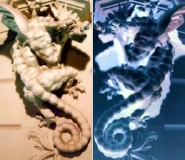Speaker
Mr
Bjoern Duling
(Technische Universitaet Muenchen, Physikdepartment)
Description
After a brief theoretical introduction of the warped extra-dimenional (WED) model with custodial protection the results of arXiv:0809.1073 are
presented. In this work we analyze the impact of Kaluza-Klein (KK) gauge boson modes on $\Delta F=2$ observables, for the first time considering the full
operator basis and including NLO RG running. It is pointed out that
the dominant contribution in the B-system does not come from the KK
gluon, but that contributions from KK excitations of the weak gauge
bosons are competitive. Among them the dominant role is played by $Z_H$ and $Z^\prime$, since the $Z$ contribution is suppressed by the custodial protection of the model (see talk by S. Gori). In a numerical analysis we assess the amount of fine tuning necessary for obtaining realistic values for quark masses and mixings and at the same time realistic values for $\epsilon_K$,
the measure for CP violation in K meson mixing. We are able to show that a mass of the lightest KK gluon of 2-3 TeV, and hence in the reach of the LHC, is still possible for moderate fine tuning. These results enable us to predict not yet measured $\Delta F=2$ observables, such as $S_{\psi\phi}$ and $A_s^{SL}$, which can differ significantly from their SM values.
Authors
Dr
Andreas Weiler
(Institute for High Energy Phenomenology, Cornell University, Ithaca)
Prof.
Andrzej Buras
(Technische Universitaet Muenchen, Physikdepartment and TUM Institute for Advanced Study, Munich)
Mr
Bjoern Duling
(Technische Universitaet Muenchen, Physikdepartment)
Ms
Monika Blanke
(Technische Universitaet Muenchen, Physikdepartment and Max-Planck-Institut für Physik, Munich)
Ms
Stefania Gori
(Technische Universitaet Muenchen, Physikdepartment and Max-Planck-Institut für Physik, Munich)
